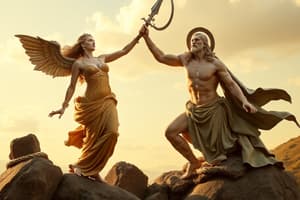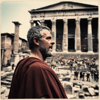Podcast
Questions and Answers
What was the main purpose of the blood sacrifice in ancient Greece?
What was the main purpose of the blood sacrifice in ancient Greece?
- To cook food for the community
- To strengthen community ties
- To honour the gods (correct)
- To celebrate victories in battle
Which type of sacrifice was considered the most expensive?
Which type of sacrifice was considered the most expensive?
- A single sheep offering
- A chicken offering
- A hecatomb (correct)
- A piglet offering
Which of the following was NOT a stage in the sacrifice process?
Which of the following was NOT a stage in the sacrifice process?
- The preparation
- The feast (correct)
- The sharing of the sacrifice
- The kill
What was the role of musicians during the sacrifice?
What was the role of musicians during the sacrifice?
What was done with the horns of the animal prior to the sacrifice?
What was done with the horns of the animal prior to the sacrifice?
Who carried the basket containing barley grains or cakes during the sacrifice?
Who carried the basket containing barley grains or cakes during the sacrifice?
Before the sacrifice began, participants would ensure they were clean to avoid what?
Before the sacrifice began, participants would ensure they were clean to avoid what?
What would signify a negative sign from the gods during the sacrifice?
What would signify a negative sign from the gods during the sacrifice?
What was the primary role of the altar in the sacrificial ritual?
What was the primary role of the altar in the sacrificial ritual?
Why did the sacrificer pour water on the animal's head?
Why did the sacrificer pour water on the animal's head?
What was the significance of the chief sacrificer removing hair from the animal?
What was the significance of the chief sacrificer removing hair from the animal?
What did the participants do with their grain during the ritual?
What did the participants do with their grain during the ritual?
What part of the animal was specifically reserved for the god?
What part of the animal was specifically reserved for the god?
How was the communal aspect of the sacrifice highlighted?
How was the communal aspect of the sacrifice highlighted?
What was done with the entrails of the animal?
What was done with the entrails of the animal?
What ultimately happened to the animal's skin after the sacrifice?
What ultimately happened to the animal's skin after the sacrifice?
Flashcards
Blood Sacrifice
Blood Sacrifice
The ritual killing of an animal to honor the gods and appease them. It involved a precise sequence of steps.
Hetacomb Sacrifice
Hetacomb Sacrifice
A grand sacrifice involving the killing of 100 oxen. It was a lavish offering reserved for important festivals.
Sacrifice Preparation
Sacrifice Preparation
The process of cleansing participants, preparing the chosen animal, and leading it to the altar.
Sacrificial Animal Choice
Sacrificial Animal Choice
Signup and view all the flashcards
Role of Musicians
Role of Musicians
Signup and view all the flashcards
Importance of Cleanliness
Importance of Cleanliness
Signup and view all the flashcards
Attendants in the Procession
Attendants in the Procession
Signup and view all the flashcards
Symbolic Meaning of the Sacrifice
Symbolic Meaning of the Sacrifice
Signup and view all the flashcards
Importance of the Altar
Importance of the Altar
Signup and view all the flashcards
Animal's Consent
Animal's Consent
Signup and view all the flashcards
Throwing Grain
Throwing Grain
Signup and view all the flashcards
Animal's Hair Ritual
Animal's Hair Ritual
Signup and view all the flashcards
Pouring Blood
Pouring Blood
Signup and view all the flashcards
Women's Scream
Women's Scream
Signup and view all the flashcards
God's Portion
God's Portion
Signup and view all the flashcards
Communal Feast
Communal Feast
Signup and view all the flashcards
Study Notes
Greek Sacrifices
- Greeks offered gifts to honor gods, including money, songs, war booty, and food offerings.
- Animal sacrifices were the most common food offering.
- Rituals involved careful preparation stages.
- Animals were chosen based on the god and the person making the sacrifice.
- Some animals were more expensive than others (e.g., a hecatomb involved 100 oxen).
- Sacrifice steps included preparation, killing, and sharing.
Preparation
- Participants prepared by ensuring they were clean and dressed appropriately (e.g., with garlands).
- Animals were cleaned, horns gilded (if applicable), and led to the altar.
- A maiden carried barley grains or cakes.
- Musicians were often present to reduce animal stress.
- Participants cleansed themselves with water and gathered around the altar.
- Fire was lit on the altar.
- Participants would ritually offer grain to the god and confirm agreement to the sacrifice.
The Kill
- Chief sacrificer used a knife to remove animal hair and cut the animal's throat.
- Large animals had bowls to collect blood, small animals were held above the altar.
- Blood was poured over the altar.
- Women made a high-pitched scream.
Sharing the Sacrifice
- Sacrifice meat first went to the god(s) as their portion.
- The god's portion was prepared by removing thigh bones, wrapping them in fat, and burning them.
- After gods' consumption, entrails of the animal were read for omens.
- Leftover meat was shared with the community.
- Preparing and sharing the sacrifice was a way to strengthen community bonds and celebrate participation.
- Skin of the animal was often given to the temple or the sanctuary.
Studying That Suits You
Use AI to generate personalized quizzes and flashcards to suit your learning preferences.





